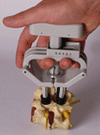Applied Kinesiology stems from the idea that weak muscles can cause postural distortion. By applying appropriate therapies to strengthen the muscles, posture will improve. Muscle testing can identify what muscles are weak. When the muscle becomes strong, muscle testing can also confirm if the correct therapy has been applied. There are many reasons for muscle weakness, including an atlas misalignment, nerve root impingement, injury to a joint or to the actual muscle, toxins, emotional and mental states, and finally nutritional deficiencies.
Dr. Polsinelli has been practicing Applied Kinesiology since 1992. He finds that it is a quick and effective way to identify patients’ problems, as well as find the solution for those problems. Kinesiology is also a quick and easy way to identify nutrition, toxin, and allergy issues.
 I also use a gentle positional release technique. It is based on the idea that the body heals itself. By putting our bodies into a position that is most comfortable, we relax, and our body reintegrates and comes to a better balance. It is based on the work of osteopath Dr. Lawrence Jones and Dr. Arthur Lincoln Pauls. Similar to the idea in homeopathy in that like cures like, positional releases can address chronic problems by exaggerating muscle and postural distortion. How this feels is comfort and relief and relaxation. We want it to feel good.
I also use a gentle positional release technique. It is based on the idea that the body heals itself. By putting our bodies into a position that is most comfortable, we relax, and our body reintegrates and comes to a better balance. It is based on the work of osteopath Dr. Lawrence Jones and Dr. Arthur Lincoln Pauls. Similar to the idea in homeopathy in that like cures like, positional releases can address chronic problems by exaggerating muscle and postural distortion. How this feels is comfort and relief and relaxation. We want it to feel good.
There are several ways to address tension within the positional release. One is a structural positional release phase where we are looking for the most comfortable position and staying there until there is a release and relaxation in the body. Another is where there is a blend of position and motion where we look for the most comfortable movement for the body part. It can be large or minuscule movement based on the body part and personal need. Finally, there is an energetic component of mirroring distorted energetic patterns that manifest in physical complaints.
He also includes isometric exercises to help wake up muscles, as well as cranial, posture, and movement techniques to help integrate after a release.
Dr. Polsinelli has been utilizing positional release techniques since 1991 and has had hundreds of hours of training in it.
The Vetebral Distraction Pump is a precision tool to remove nerve root impingement caused by disc herniation and stenosis. Once the proper level is identified, gentle pressure is directed toward spreading or “distracting” the vertebrae away from each other to relieve pressure from the nerve root. It should feel mildly uncomfortable to really good. It should not be painful. Dr. Polsinelli has found this useful for chronic nerve root impingement issues.
root impingement caused by disc herniation and stenosis. Once the proper level is identified, gentle pressure is directed toward spreading or “distracting” the vertebrae away from each other to relieve pressure from the nerve root. It should feel mildly uncomfortable to really good. It should not be painful. Dr. Polsinelli has found this useful for chronic nerve root impingement issues.
